Abstract
Measles virus (MV) is known to depress T cell function. In order to determine whether this results from alteration in the production of, or response to, interleukin-2 (IL-2) we studied the effect of in vitro infection with MV on human IL-2 dependent T cell lines. MV produced a cytopathic productive infection in these cells. Class I allospecific cytotoxic T cells retained their cytotoxic activity 48 h after infection. Both cytotoxic and Leu 3a/4a positive T cell lines continued to respond to IL-2 by proliferation up to 26 h after infection. The ability of human tonsillar lymphocytes to generate IL-2 in response to phytohaemagglutinin following MV infection was then studied. In early measles infection (up to 48 h) there was no suppression of IL-2 production: in fact measles infected cells spontaneously released low levels of IL-2 in the absence of lectin. Similarly, IL-2 release was not affected by Herpes simplex virus infection of such cultures, although lymphocytes infected with Sendai or respiratory syncytial viruses produced considerably less IL-2. These observations suggest that MV-induced immunosuppression is not a result of inhibition of differentiated T cell function, IL-2 generation or responsiveness, but may be more directly related to virus-induced cytopathic effects in activated T cells.
Full text
PDF
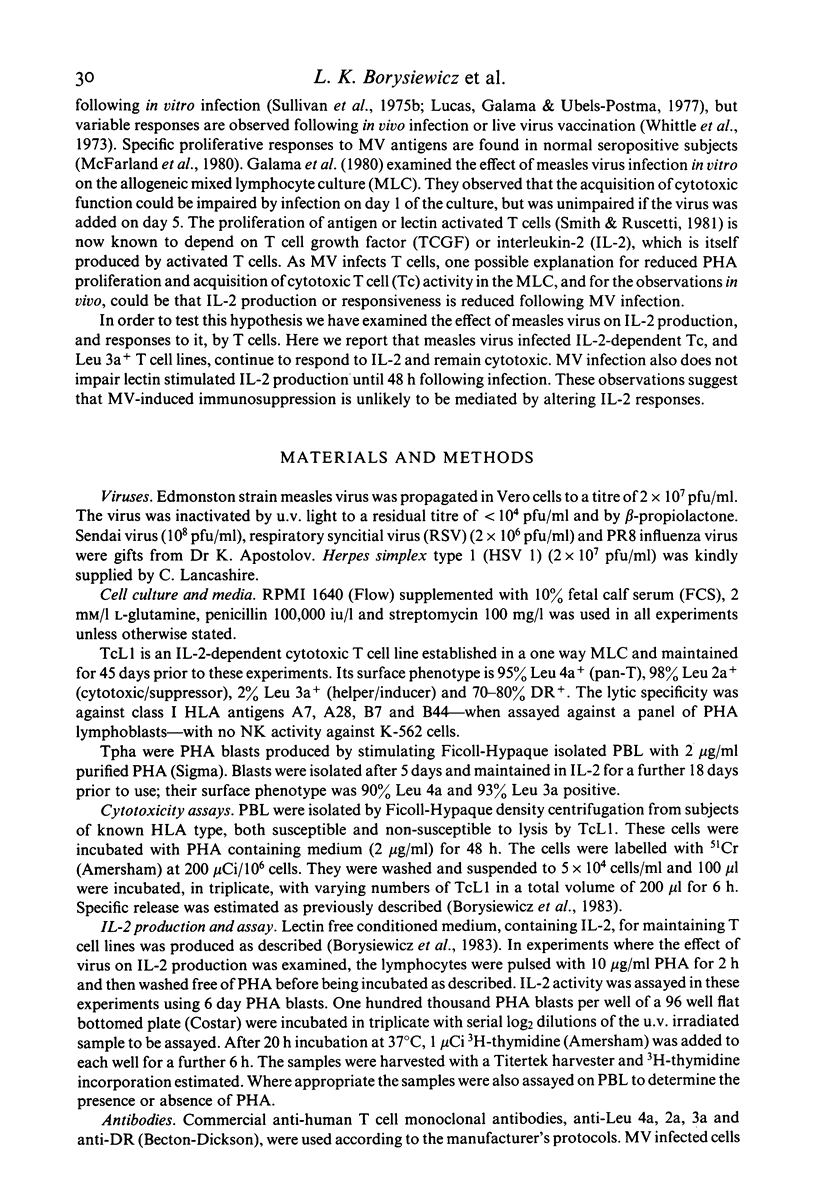
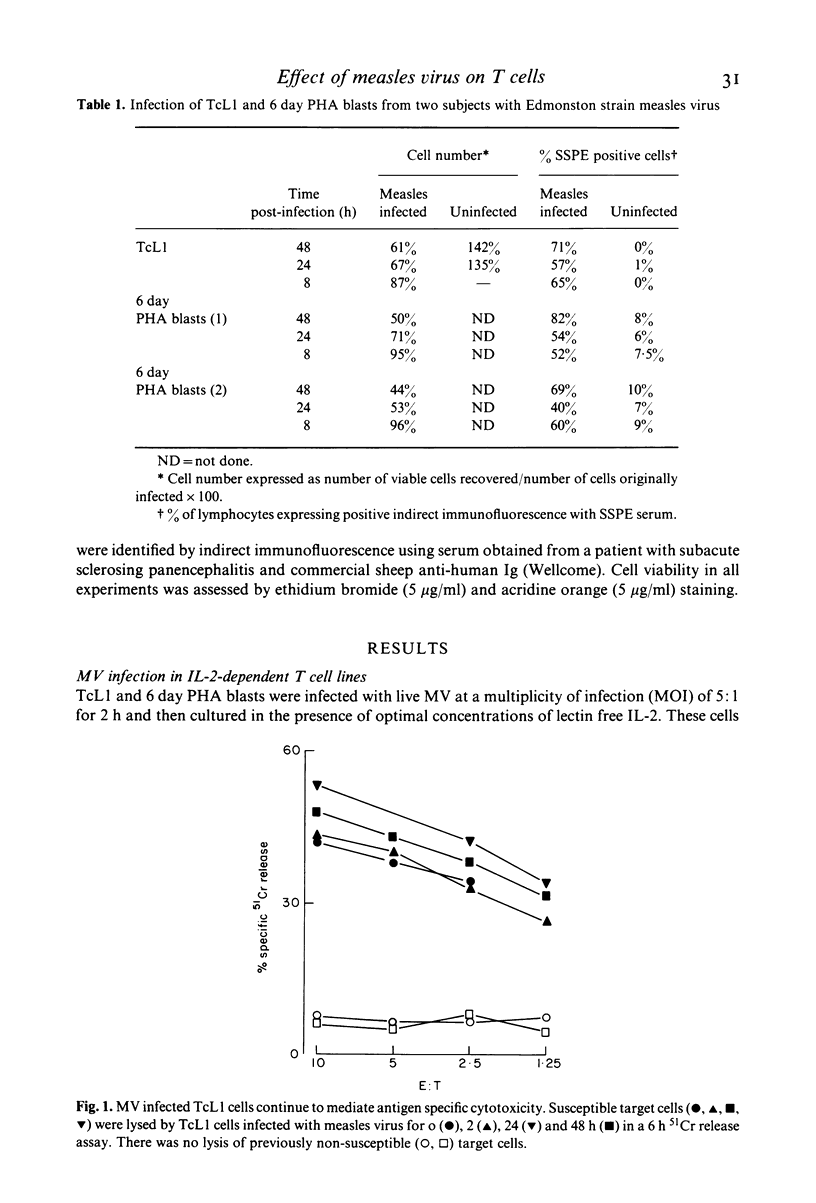
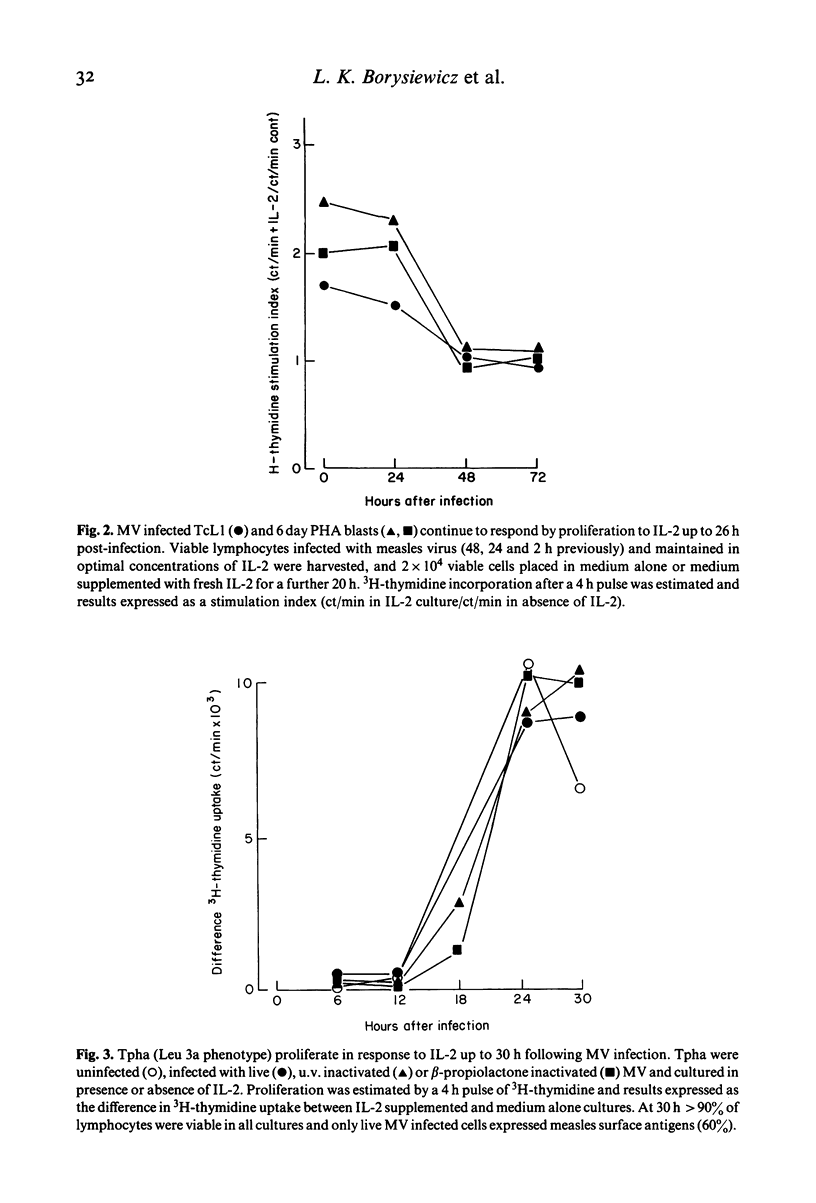
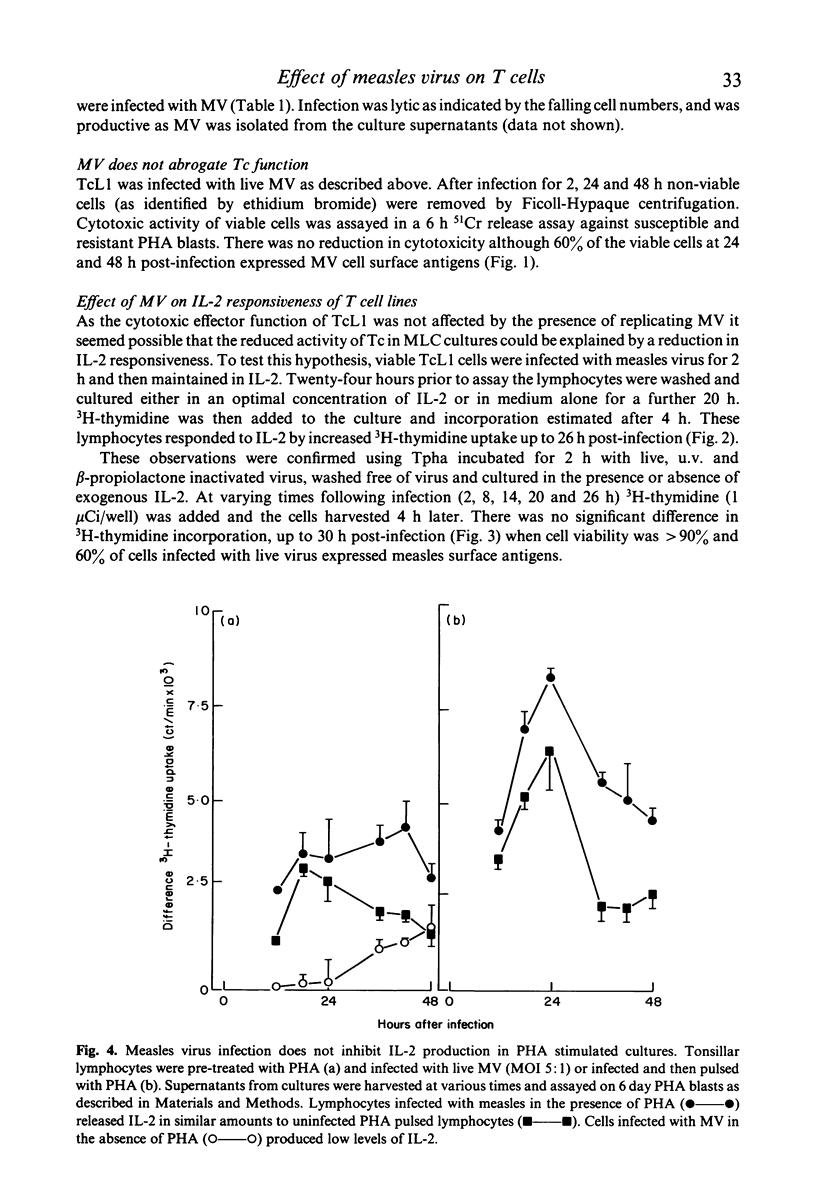
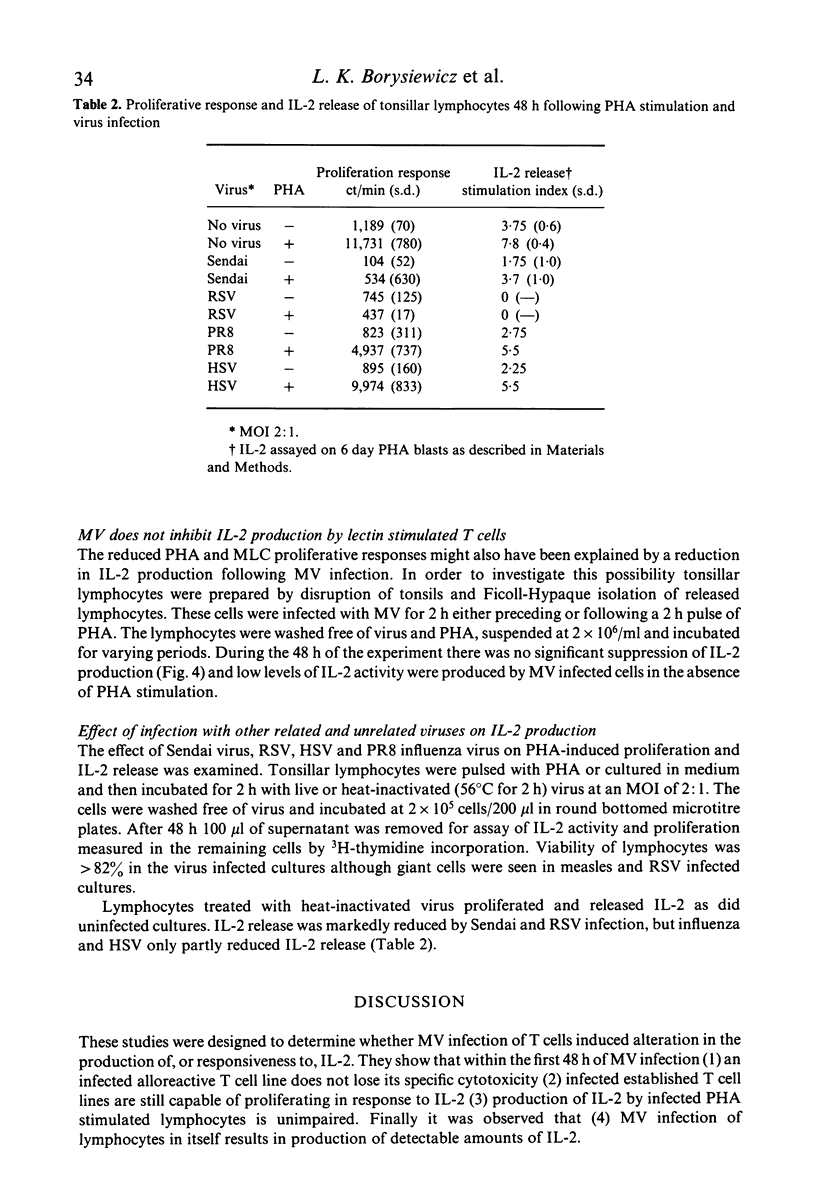
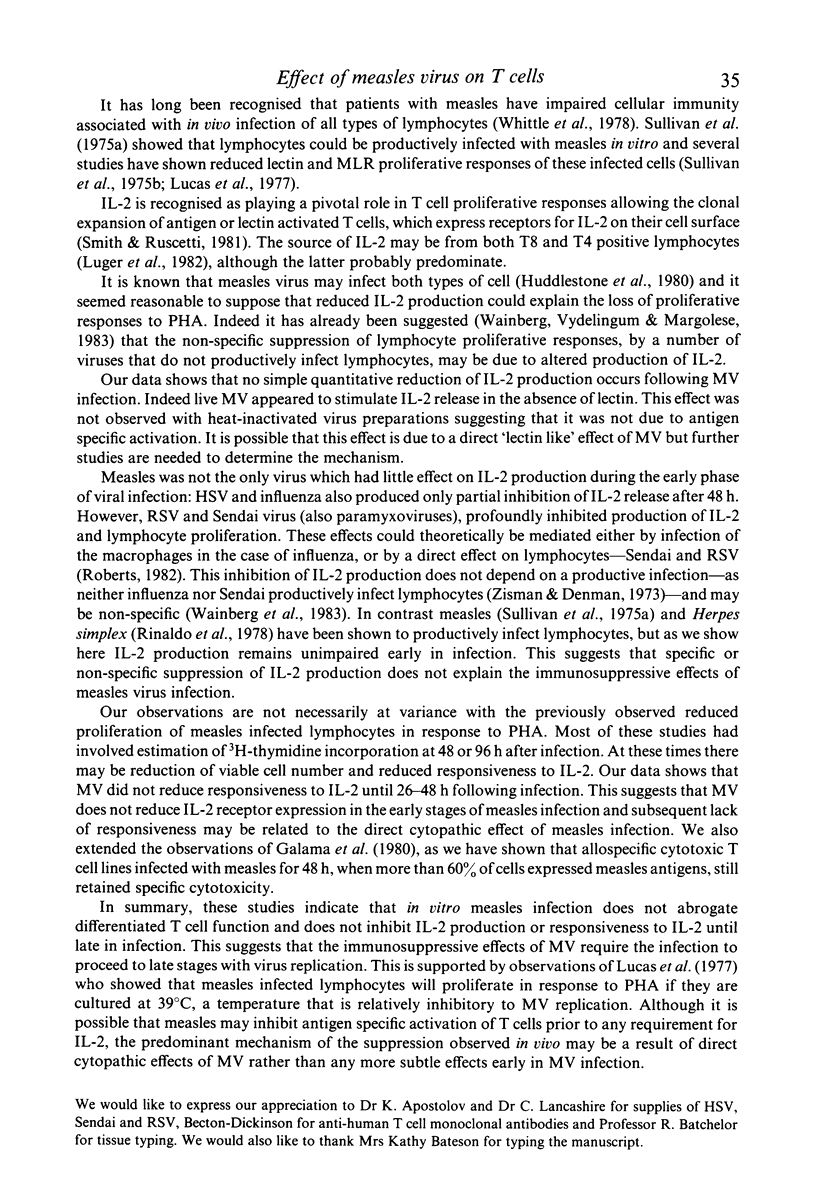
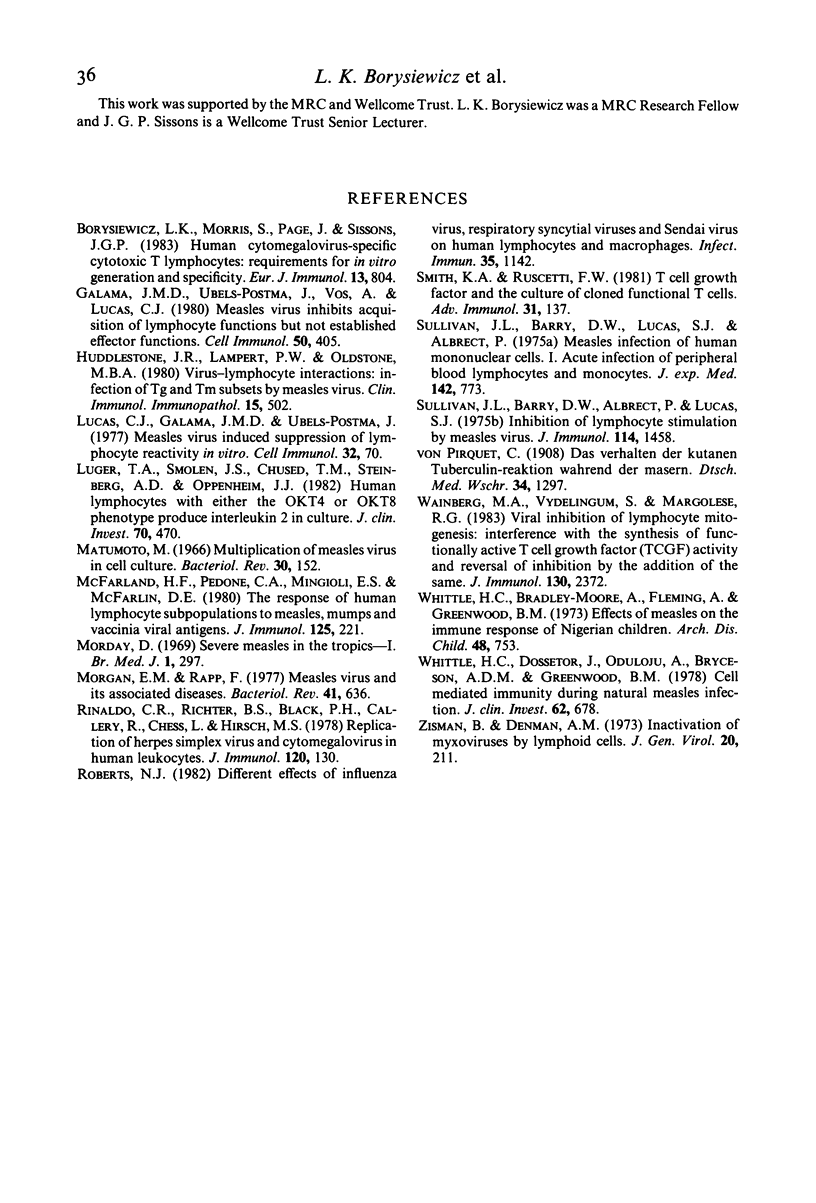
Selected References
These references are in PubMed. This may not be the complete list of references from this article.
- Borysiewicz L. K., Morris S., Page J. D., Sissons J. G. Human cytomegalovirus-specific cytotoxic T lymphocytes: requirements for in vitro generation and specificity. Eur J Immunol. 1983 Oct;13(10):804–809. doi: 10.1002/eji.1830131005. [DOI] [PubMed] [Google Scholar]
- Galama J. M., Ubels-Postma J., Vos A., Lucas C. J. Measles virus inhibits acquisition of lymphocyte functions but not established effector functions. Cell Immunol. 1980 Mar 15;50(2):405–415. doi: 10.1016/0008-8749(80)90294-4. [DOI] [PubMed] [Google Scholar]
- Huddlestone J. R., Lampert P. W., Oldstone M. B. Virus-lymphocyte interactions: infection of Tg and Tm subsets by measles virus. Clin Immunol Immunopathol. 1980 Mar;15(3):502–509. doi: 10.1016/0090-1229(80)90062-8. [DOI] [PubMed] [Google Scholar]
- Luger T. A., Smolen J. S., Chused T. M., Steinberg A. D., Oppenheim J. J. Human lymphocytes with either the OKT4 or OKT8 phenotype produce interleukin 2 in culture. J Clin Invest. 1982 Aug;70(2):470–473. doi: 10.1172/JCI110637. [DOI] [PMC free article] [PubMed] [Google Scholar]
- Matumoto M. Multiplication of measles virus in cell cultures. Bacteriol Rev. 1966 Mar;30(1):152–176. doi: 10.1128/br.30.1.152-176.1966. [DOI] [PMC free article] [PubMed] [Google Scholar]
- McFarland H. F., Pedone C. A., Mingioli E. S., McFarlin D. E. The response of human lymphocyte subpopulations to measles, mumps, and vaccinia viral antigens. J Immunol. 1980 Jul;125(1):221–225. [PubMed] [Google Scholar]
- Morgan E. M., Rapp F. Measles virus and its associated diseases. Bacteriol Rev. 1977 Sep;41(3):636–666. doi: 10.1128/br.41.3.636-666.1977. [DOI] [PMC free article] [PubMed] [Google Scholar]
- Morley D. Severe measles in the tropics. I. Br Med J. 1969 Feb 1;1(5639):297–contd. doi: 10.1136/bmj.1.5639.297. [DOI] [PMC free article] [PubMed] [Google Scholar]
- Rinaldo C. R., Jr, Richter B. S., Black P. H., Callery R., Chess L., Hirsch M. S. Replication of herpes simplex virus and cytomegalovirus in human leukocytes. J Immunol. 1978 Jan;120(1):130–136. [PubMed] [Google Scholar]
- Roberts N. J., Jr Different effects of influenza virus, respiratory syncytial virus, and Sendai virus on human lymphocytes and macrophages. Infect Immun. 1982 Mar;35(3):1142–1146. doi: 10.1128/iai.35.3.1142-1146.1982. [DOI] [PMC free article] [PubMed] [Google Scholar]
- Smith K. A., Ruscetti F. W. T-cell growth factor and the culture of cloned functional T cells. Adv Immunol. 1981;31:137–175. doi: 10.1016/s0065-2776(08)60920-7. [DOI] [PubMed] [Google Scholar]
- Sullivan J. L., Barry D. W., Albrecht P., Lucas S. J. Inhibition of lymphocyte stimulation by measles virus. J Immunol. 1975 May;114(5):1458–1461. [PubMed] [Google Scholar]
- Sullivan J. L., Barry D. W., Lucas S. J., Albrecht P. Measles infection of human mononuclear cells. I. Acute infection of peripheral blood lymphocytes and monocytes. J Exp Med. 1975 Sep 1;142(3):773–784. doi: 10.1084/jem.142.3.773. [DOI] [PMC free article] [PubMed] [Google Scholar]
- Wainberg M. A., Vydelingum S., Margolese R. G. Viral inhibition of lymphocyte mitogenesis: interference with the synthesis of functionally active T cell growth factor (TCGF) activity and reversal of inhibition by the addition of same. J Immunol. 1983 May;130(5):2372–2378. [PubMed] [Google Scholar]
- Whittle H. C., Bradley-Moore A., Fleming A., Greenwood B. M. Effects of measles on the immune response of Nigerian children. Arch Dis Child. 1973 Oct;48(10):753–756. doi: 10.1136/adc.48.10.753. [DOI] [PMC free article] [PubMed] [Google Scholar]
- Whittle H. C., Dossetor J., Oduloju A., Bryceson A. D., Greenwood B. M. Cell-mediated immunity during natural measles infection. J Clin Invest. 1978 Sep;62(3):678–684. doi: 10.1172/JCI109175. [DOI] [PMC free article] [PubMed] [Google Scholar]
- Zisman B., Denman A. M. Inactivation of myxoviruses by lymphoid cells. J Gen Virol. 1973 Aug;20(2):211–223. doi: 10.1099/0022-1317-20-2-211. [DOI] [PubMed] [Google Scholar]


